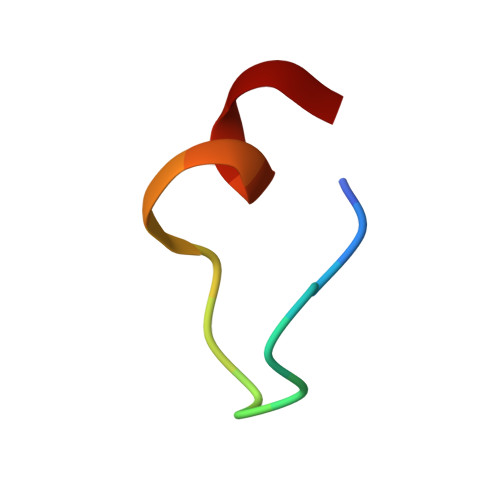The origins of binding specificity of a lanthanide ion binding peptide.
Hatanaka, T., Kikkawa, N., Matsugami, A., Hosokawa, Y., Hayashi, F., Ishida, N.(2020) Sci Rep 10: 19468-19468
- PubMed: 33173124
- DOI: https://doi.org/10.1038/s41598-020-76527-y
- Primary Citation of Related Structures:
7CCN, 7CCO - PubMed Abstract:
Lanthanide ions (Ln 3+ ) show similar physicochemical properties in aqueous solutions, wherein they exist as + 3 cations and exhibit ionic radii differences of less than 0.26 Å. A flexible linear peptide lanthanide binding tag (LBT), which recognizes a series of 15 Ln 3+ , shows an interesting characteristic in binding specificity, i.e., binding affinity biphasically changes with an increase in the atomic number, and shows a greater than 60-fold affinity difference between the highest and lowest values. Herein, by combining experimental and computational investigations, we gain deep insight into the reaction mechanism underlying the specificity of LBT3, an LBT mutant, toward Ln 3+ . Our results clearly show that LBT3-Ln 3+ binding can be divided into three, and the large affinity difference is based on the ability of Ln 3+ in a complex to be directly coordinated with a water molecule. When the LBT3 recognizes a Ln 3+ with a larger ionic radius (La 3+ to Sm 3+ ), a water molecule can interact with Ln 3+ directly. This extra water molecule infiltrates the complex and induces dissociation of the Asn5 sidechain (one of the coordinates) from Ln 3+ , resulting in a destabilizing complex and low affinity. Conversely, with recognition of smaller Ln 3+ (Sm 3+ to Yb 3+ ), the LBT3 completely surrounds the ions and constructs a stable high affinity complex. Moreover, when the LBT3 recognizes the smallest Ln 3+ , namely Lu 3+ , although it completely surrounds Lu 3+ , an entropically unfavorable phenomenon specifically occurs, resulting in lower affinity than that of Yb 3+ . Our findings will be useful for the design of molecules that enable the distinction of sub-angstrom size differences.
- Toyota Central R&D Labs., Inc., 41-1, Nagakute, Aichi, 480-1192, Japan. takaaki-h@mosk.tytlabs.co.jp.
Organizational Affiliation:

















